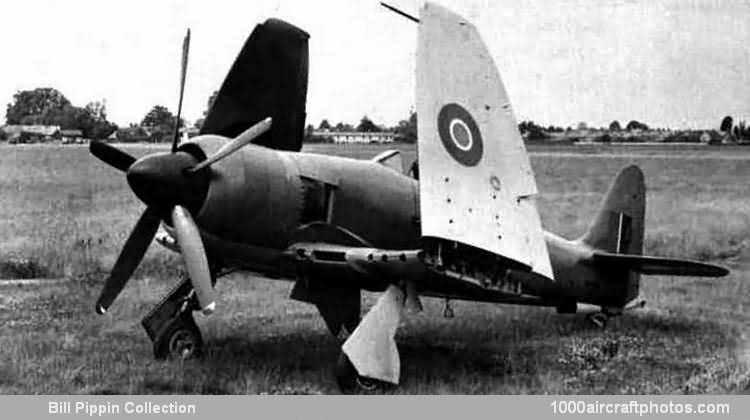02/28/2010. Remarks by Johan Visschedijk: "Shortly after the first Tempest prototype had flown in September 1942, discussions were held at Hawker to consider the possibility of a smaller and lighter version of the Tempest. In January 1943, it was decided that in producing the new design, efforts should be made to conform to the requirements of Specification F.6/42, and the resulting aircraft became known as the Tempest Light Fighter (Centaurus). Shortly afterwards a new Specification, F.2/43, was prepared, written around the proposals submitted with the Hawker design.
In April 1943, on receipt of yet another Specification, N.7/43, for a naval interceptor fighter, Hawker's Chief Designer Sydney Camm suggested to the Ministry of Aircraft Production that the F.2/43 aircraft, using an up-rated Centaurus XII engine, would be equally capable of meeting the naval Specification. The result was that both RAF and naval requirements were henceforward pooled under F.2/43, Hawker preparing the prototype and production drawings for the land-based fighter while the responsibility for the naval conversion would be entrusted to Boulton-Paul Aircraft Ltd.
Alternative power plants to the Centaurus XII were considered and by December 1943, six F.2/43 prototypes were on order of which two were to be fitted with Griffons, two with Centaurus XXIIs, one with a Centaurus XII and one to be used as a test structure. Early in 1944 another naval Specification, N.22/43, was received in which the production Standard of Preparation was set out, and in April that year a contract for 200 F.2/43 and 200 N.22/43 aircraft was placed, of which 100 of the latter were to be built by Boulton-Paul.
First of the new aircraft to fly was NX798. Flown by Lucas on 1st September, 1944, this was an F.2/43 with a rigidly-mounted Bristol Centaurus XII with Rotol four-blade propeller. Next was LA610, flown on 27th November, 1944, also to F.2/43 but powered by a Rolls-Royce Griffon 85 driving Rotol six-blade contra-rotating propellers. At this point it was decided to name the F.2/43 aircraft the Fury F.Mk.I and the naval version the Sea Fury F.Mk.X. With the end of the War in Europe in sight the Sea Fury order was reduced to 100 aircraft, and the Boulton-Paul contract was cancelled in January 1945, while the Boulton-Paul Sea Fury prototype, VB857, was delivered to Hawker for completion.
The first Sea Fury prototype, SR661, flew on February 21, 1945, also fitted with a Centaurus XII engine and Rotol four-blade airscrew. This aircraft was "semi-navalized", in that it featured deck arrester hook under the rudder but retained fixed wings. The second prototype, SR666, which flew on October 12, 1945, differed from the first in being "full-navalized" with folding wings. This machine was powered by a Centaurus XV driving a five-blade Rotol propeller (the Centaurus XXII having been delayed).
The remaining Fury prototype, NX802, with Centaurus XV, had flown on July 25, 1945, and the Boulton-Paul machine, VB857, now completed to the same standard as SR666, flew on January 31, 1946. With the end of the War in Europe came cancellation of the contract for Furies for the RAF, and interest now centered on the Sea Fury, although the Centaurus in LA610 was later replaced by the Sabre VII for test purposes (in this form the aircraft was probably the fastest piston engine Hawker aircraft, possessing a top speed in the region of 485 mph, 780 kmh).
The first fifty production Sea Furies F.Mk.Xs, were fighters based fundamentally on the prototype SR666 and passed through the Kingston shops during 1946, the first machine, TF895, being flown by R.V. Morrell on September 7. Early F.Mk.Xs featured four-blade Rotol propellers, but, resulting from tests on SR666 and TF895 (the latter retained by Hawker for development), Rotol five-blade airscrews became standard on all subsequent Sea Furies.
Deck trials with the Sea Fury, TF898, commenced aboard HMS Victorious during the winter of 1946-47, but Service clearance was delayed until the spring of 1947 due to arrester hooks being damaged on several occasions, resulting in an interim modification. Sea Furies were issued to Nos. 778, 802, 803, 805 and 807 Squadrons of the Fleet Air Arm, but during 1948 their replacement commenced with the introduction of the Sea Fury F.B.Mk.11.
Trials had been continued during 1947 on SR666 at Langley with various combinations of incendiary bombs, Smoke Floats, rocket projectiles, drop tanks and Napalm tanks; similar parallel trials had been conducted on a production F.Mk.X, TF923, at Boscombe Down. Other alterations had also been introduced, including the lengthening of the arrester hook and provision made to incorporate rocket-assisted take off gear (RATOG). The outcome of these improvements was the introduction to service, with immediate clearance, of the F.B.Mk.11."
